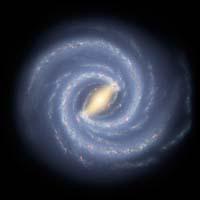Dust of stars, vivid
In recent years, astronomers have detected organic molecules in meteorites and in open space. Of course, they are not seen with optical telescopes, but have been detected with radio telescopes. These molecules emit radio waves that receive radio telescopes. Thus, astronomers have discovered more than 140 life-related molecules, especially in an area located in the center of the Milky Way, in a compact cloud of gas and dust called LMH.

Astronomers have detected an organic molecule outside the center of the Milky Way and 26,000 light-years from Earth. (Photo: Recent searches
Some of these molecules are also found on Earth. Among them are acetic acid, vinegar and ethylene glycol, the main component of antifreeze. Aldehyde glycol has also been detected in this central area of the Milky Way.
This molecule is made up of carbon, hydrogen and oxygen and is the simplest sugar. Attached to other molecules it produces more complex molecules like ribose. Ribose, for its part, is a basic component of RNA that is directly related to the origin of life.
Well, according to a hypothesis, life on Earth is due to molecules coming from space. And the detection of organic molecules in space gives strength to this hypothesis. However, until now no molecules of this type were found in areas that could be similar to those of the place where the Earth was born.
In the article they now publish, however, it has been announced the discovery of a glycol aldehyde, far from the center of the Milky Way, in an area of star generation. This field, called G31.41+0.31, has detected not only massive stars, but phenomena similar to those of the formation of the Sun, which astronomers believe may be one of the few places where stars similar to the Sun are occurring.
Important discovery
And there, thanks to the IRAM radio telescope located in the Alps, they discovered the aldehyde glycol. According to astronomers who have discovered, the discovery of aldehyde glycol is important for two reasons. On the one hand, in the center of the Milky Way there is a great radiation that reduces the possibilities of life generation. However, the G31.41+0.31 is far from the center, so if biological processes were initiated they would have more chances to move forward.
On the other hand, the high number of aldehyde glycol found suggests that this molecule is typical of areas where stars are being produced. Furthermore, organic molecules may coincide with the birth of stars and planets.
However, there is a wide margin of life generation from the formation of organic molecules. In fact, on newborn planets conditions are extreme and it is very difficult for organic molecules to remain in those conditions. However, over time, young planets tend to stabilize and calm their environments, and perhaps then yes: then it is possible that a comet or meteorite will sow organic molecules on the surface of the planet and from them generate life. It is a hypothesis, but at least they have found a trace.
Published in Gara
Buletina
Bidali zure helbide elektronikoa eta jaso asteroko buletina zure sarrera-ontzian











